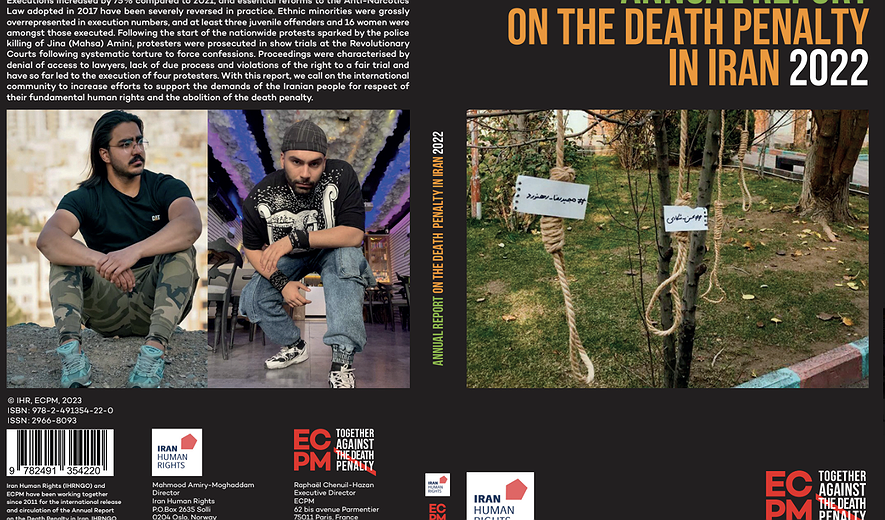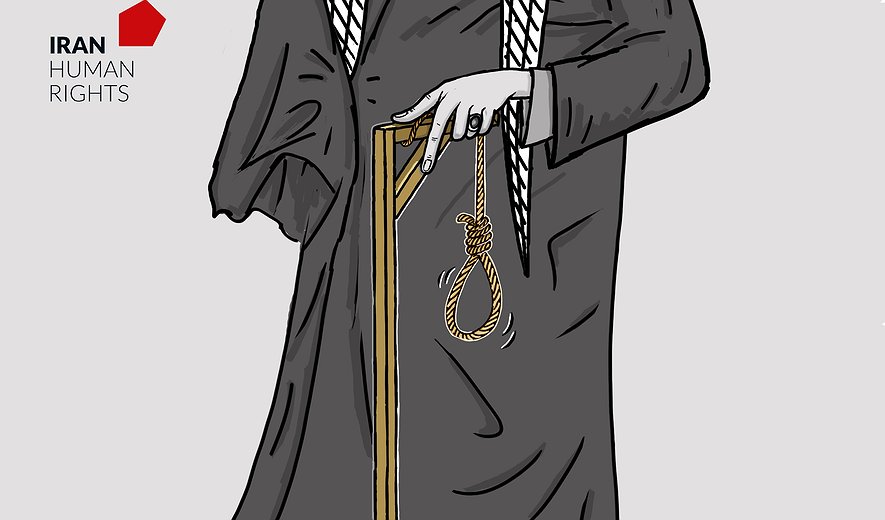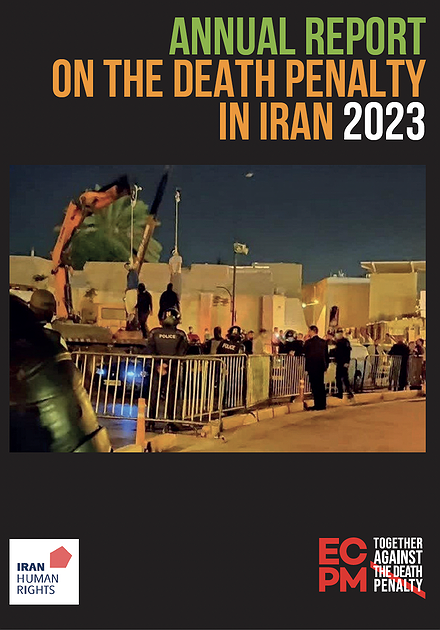Annual Report of the Death Penalty in Iran 2022

The 15th Annual Report on the Death Penalty in Iran, by Iran Human Rights and ECPM reveals the highest annual number of executions since 2015. At least 582 people were executed, an increase of 75% compared to 2021. In 2022, Iran’s authorities demonstrated how crucial the death penalty is to instil societal fear in order to hold onto power.
2022 Annual Report at a glance
- At least 582 people were executed in 2022, a 75% increase compared to 333 in 2021
- 71 executions (12%) were announced by official sources compared to 16.5% in 2021 and an average of 33% in 2018-2020
- 88% of all executions included in the 2022 report, i.e. 511 executions, were not announced by the authorities
- At least 288 executions (49% of all executions) were for murder charges, the highest in more than 15 years
- At least 256 (44 %) were executed for drug-related charges compared to 126 (38%) in 2021 and an average of 24 per year in 2018-2020
- Only 3 of the 256 drug-related executions (1.2%) were announced by official sources
- At least 23 people were executed for rape charges
- At least 15 people, among them 2 protesters, were executed for security-related charges (moharebeh and efsad-fil-arz)
- Two people, including one protester, were hanged in public spaces
- At least 3 juvenile offenders were among those executed
- At least 16 women were executed
- At least 273 executions in 2022 and more than 4,029 executions since 2010 have been based on death sentences issued by the Revolutionary Courts
At least 624 prisoners sentenced to death for murder charges were forgiven by the families of the murder victims per qisas laws
Weeks into the nationwide “Woman-Life-Freedom” protests, triggered by the state killing of Jina (Mahsa) Amini on 16 September 2022, hundreds of protesters were facing show trials at the Revolutionary Courts, many with charges punishable by death. Two protesters were executed in December 2022. At the time of publishing this report, four protesters have been executed, more than 100 protesters remain at risk of death penalty charges, sentences and execution and at least 20 others have been sentenced to death in preliminary trials. Strong international backlash, parliamentarians volunteering as “political sponsors” to save death row protesters, and targeted sanctions against individuals and entities involved in the repression, have raised the political cost of executing protesters. In response, authorities intensified the execution of prisoners with non-political charges. At least 127 people were executed in the months of November and December 2022, 67 for drug-related and 53 for murder charges. Unfortunately, international reactions have been lacking against the execution of non-political prisoners. This trend has continued into 2023.
Commenting on the report, Iran Human Rights Director, Mahmood Amiry-Moghaddam said: “The international reactions to the death sentences against protesters have made it difficult for the Islamic Republic to proceed with their executions. To compensate, and in order to spread fear among people, the authorities have intensified the execution for non-political charges. These are the low-cost victims of the Islamic Republic’s execution machine. In order to stop this machine, the international community and civil society inside and outside Iran must show the same reaction to each and every execution”.
More than half of those executed after the start of the protests, and 256 (44%) of the 582 executions recorded in 2022, had been sentenced to death for drug-related charges. This is a more than two-fold increase compared to 2021, and ten times higher than the number of drug-related executions in 2020. Despite a ten-fold increase in the executions for drug charges, neither the United Nations Office for Drugs and Crimes (UNODC) nor the countries funding UNODC projects in Iran have shown any reaction to this dramatic surge. The significant reduction in the number of drug-related executions which came as a result of the 2017 Amendment to the Anti-Narcotics Law has now completely reversed in practice.
Commenting on the alarming rise in drug-related executions, ECPM Director Raphael Chenuil-Hazan said: “The positive reforms in the Anti-Narcotics Law were a result of coordinated pressure by the UNODC, donor countries and the civil society organisations. Lack of reaction by the UNODC and donor countries to the reversal of these reforms sends the wrong signal to the Iranian authorities. Abolition of the death penalty for drug-related offences must be a precondition for all future cooperation between UNODC and Iran on combating drug trafficking.”
2022 marked the year when censorship and the lack of transparency in the Islamic Republic reached its highest peak in the last 10 years. More than 88% of all executions, and 99% of drug-related executions were not officially announced by the authorities.
The execution of ethnic minorities also continued to rise in 2022. Collected data shows that Baluch prisoners accounted for 30% of all executions, while only representing 2-6% of Iran’s population. According to the present report, 130 people were executed in the 4 ethnic provinces of Western Azerbaijan, Eastern Azerbaijan, Sistan and Baluchistan and Kurdistan in 2022. This is more than double the number in 2021 (62), and in 2020 (60). Moreover, in the last ten years, the majority of prisoners executed for security related charges belonged to the ethnic Arab, Baluch, and Kurd minorities. Ethnic minorities are amongst the socio-economically marginalised groups in Iran. The death penalty is part of the systematic discrimination and extensive repression ethnic minorities of Iran are subjected to.
As in the previous five years, murder charges accounted for the largest number of executions. At least 288 people, including 3 juvenile offenders and 13 women were sentenced to qisas (retribution-in-kind) for murder charges and executed in 2022. This is the highest number of qisas executions in the last 15 years. Iranian law considers qisas to be the right of the victim’s family and as the plaintiff, it places responsibility on them to decide whether the defendant should be executed or not, and encourages them to personally carry out the execution. Furthermore, there is no distinction between premeditated murder and manslaughter. Commenting on the qisas executions, Mahmood Amiry-Moghaddam said: “Majority of those executed for murder charges in Iran are not accused of premeditated murder. A change in the law where a distinction is made between premeditated murder and manslaughter can significantly limit the use of the death penalty in Iran. But, as for the Anti-Narcotics Law, change requires sustained international pressure”.
Finally, forced confessions extracted under torture, denial of access to lawyers, due process and fair trials, and a judiciary which functions as a repressive organ of government without separation of powers and judicial independence, are key obstacles in the abolition of the death penalty in Iran. More than 44 years since their establishment, the Revolutionary Courts are still responsible for a large number of death sentences issued in Iran. Mohsen Shekari was arrested at the nationwide protests on September 25. He was tortured to force confessions and without a lawyer, he was sentenced to death on charges of moharebeh in a show trial. His crime had been to block a street with rubbish bins and using a knife in self-defence, causing injury. He was executed on December 8, just 75 days from arrest.
In 2022, public executions also returned to the streets of Iran after a two-year hiatus. Two people, Iman Sabzikar and protester Majidreza Rahnavard, were publicly executed in Shiraz and Mashhad, with more death row prisoners facing the same fate. Afghan nationals, Mohammad Ramez Rashidi and Naeim Hashem Ghotali are awaiting public executions after being sentenced to death without due process and fair trials, with Mohammad’s torture-tainted confessions aired prior to any legal proceedings taking place. Dual-nationals, Habib Asyoud (Swedish-Iranian) and Jamshid Sharmahd (German-Iranian) who were both kidnapped from neighbouring countries and subjected to torture and ill-treatment, were sentenced to death in unfair trials and are currently at risk of execution.
Simultaneously, calls for accountability and justice have increased in Iran and gained the support of the international community. On 30 September 2022, the International People’s Tribunal (The Aban Tribunal in reference to the month of “Aban'' when the repression took place in Iran at the end of 2019) which Iran Human Rights and ECPM had joined Justice For Iran to establish, delivered its judgement in London. The panel of six unanimously found that the Islamic Republic was responsible for committing crimes against humanity during the November 2019 protests, and their verdict stressed that 13 of the individuals found guilty of planning and implementing these crimes against humanity remain engaged with government in senior roles and are leading the repression of the current protests.
Finally, on 24 November 2022, in a historic move, the UN Human Rights Council adopted Resolution S35/1 to establish an International Independent Fact-Finding Mission (IFMM) on the Islamic Republic of Iran’s human rights violations since the start of the “Woman-Life-Freedom” protests. The IFMM’s findings will be presented to the Council at its fifty-fifth session (March 2024). These findings can be the basis of holding those responsible for the grave human rights violation in Iran accountable in a future court of law.
On the launch of the 2022 Annual Report on the Death Penalty in Iran, Iran Human Rights and ECPM call for an immediate moratorium on the death penalty in Iran. The organisations also call on the international community, in particular the UNODC and the States with diplomatic ties with the Islamic Republic and all other Member States, to play a more active role in supporting the improvement of the human rights situation by promoting the abolition of the death penalty in Iran. Today, 147 States in the world have abolished the death penalty or observe a moratorium on the executions. Of the 57 member states of the Organisation of the Islamic Cooperation, 20 have abolished the death penalty in law and 14 observe moratorium on executions.

